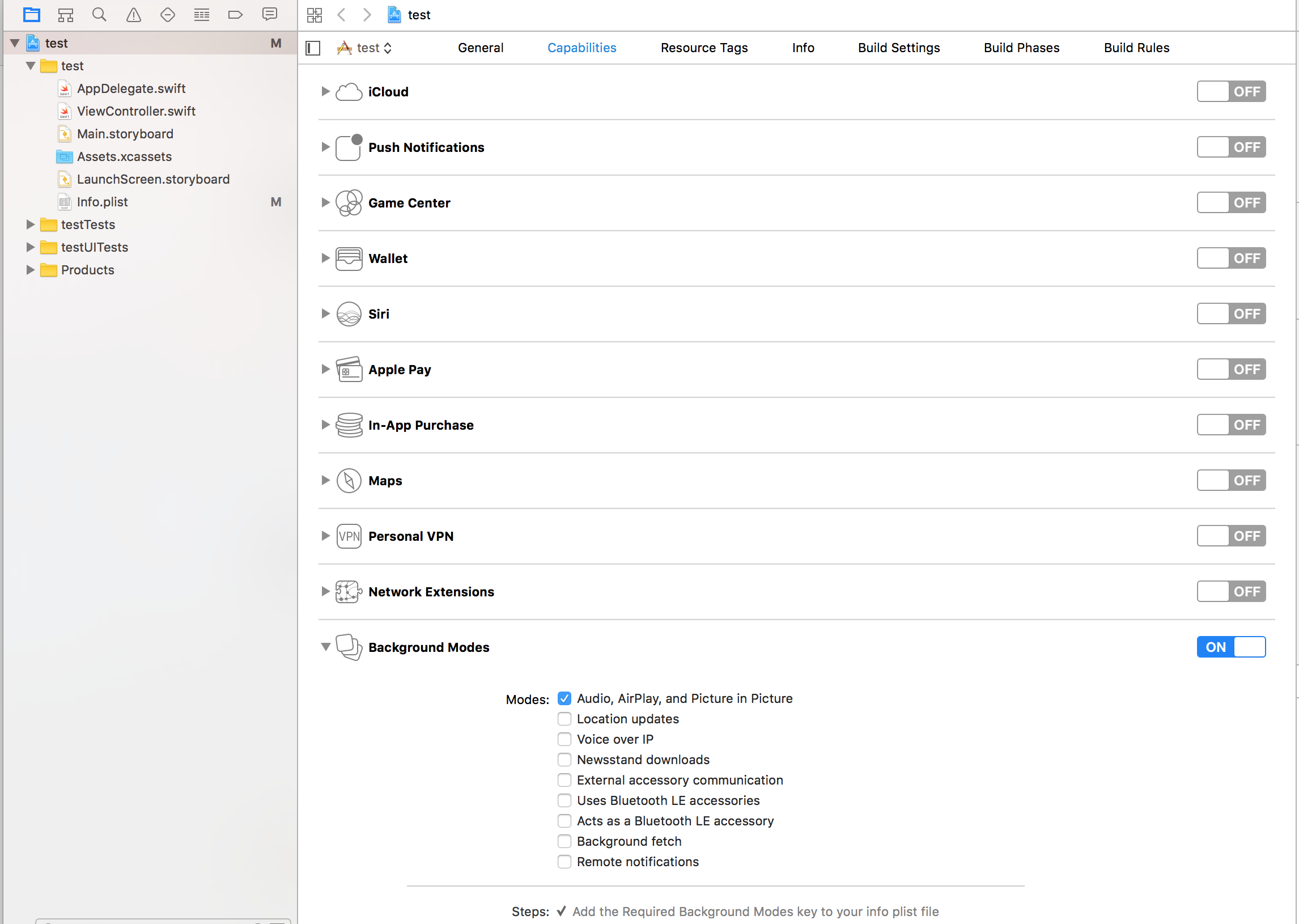react-native-music-control
React Native Music Control is a module to enable remote controls and display "Now Playing" info on the lock screen and in the notification area on Android and iOS.
Plays well with React Native Sound.
Mix between:
Project using this repo:

Installation Process
- Add it to your project
npm install react-native-music-control --save
- Link it to your project
Linking on iOS
Automatic
react-native link
:warning: You must enable Audio Background mode in XCode project settings :

Manual
In XCode, right click Libraries. Click Add Files to "[Your project]". Navigate to node_modules/react-native-music-control. Add the file MusicControl.xcodeproj.
In the Project Navigator, select your project. Click the build target. Click Build Phases. Expand Link Binary With Libraries. Click the plus button and add libMusicControl.a under Workspace.
CocoaPods
pod 'react-native-music-control', :path => '../node_modules/react-native-music-control'
Run pod install in /ios folder.
Linking on Android
Automatic
react-native link
Add following to your project AndroidManifest.xml
<uses-permission android:name="android.permission.FOREGROUND_SERVICE" />
Manual
android/app/build.gradle
dependencies {
...
compile "com.facebook.react:react-native:+" // From node_modules
+ compile project(':react-native-music-control')
}
android/settings.gradle
...
include ':app'
+include ':react-native-music-control'
+project(':react-native-music-control').projectDir = new File(rootProject.projectDir, '../node_modules/react-native-music-control/android')
MainApplication.java
+import com.tanguyantoine.react.MusicControl;
public class MainApplication extends Application implements ReactApplication {
//......
@Override
protected List<ReactPackage> getPackages() {
return Arrays.<ReactPackage>asList(
+ new MusicControl(),
new MainReactPackage()
);
}
//......
}
Add following to your project AndroidManifest.xml
<uses-permission android:name="android.permission.FOREGROUND_SERVICE" />
Troubleshooting
Some users reported this error while compiling the Android version:
Multiple dex files define Landroid/support/v4/accessibilityservice/AccessibilityServiceInfoCompat
To solve this, issue just copy this line at the end of your application build.gradle
android/app/build.gradle
+configurations.all {
+ resolutionStrategy.eachDependency { DependencyResolveDetails details ->
+ def requested = details.requested
+ if (requested.group == 'com.android.support') {
+ if (!requested.name.startsWith("multidex")) {
+ details.useVersion '26.0.1'
+ }
+ }
+ }
+}
Usage
import MusicControl from 'react-native-music-control';
Enable and Disable controls
iOS: Lockscreen
Android: Notification and external devices (smartwatches, cars)
MusicControl.enableControl('play', true)
MusicControl.enableControl('pause', true)
MusicControl.enableControl('stop', false)
MusicControl.enableControl('nextTrack', true)
MusicControl.enableControl('previousTrack', false)
MusicControl.enableControl('changePlaybackPosition', true)
MusicControl.enableControl('seekForward', false)
MusicControl.enableControl('seekBackward', false)
MusicControl.enableControl('seek', false)
MusicControl.enableControl('skipForward', false)
MusicControl.enableControl('skipBackward', false)
MusicControl.enableControl('setRating', false)
MusicControl.enableControl('volume', true)
MusicControl.enableControl('remoteVolume', false)
MusicControl.enableControl('enableLanguageOption', false)
MusicControl.enableControl('disableLanguageOption', false)
skipBackward and skipForward controls on accept additional configuration options with interval key:
MusicControl.enableControl('skipBackward', true, {interval: 15}))
MusicControl.enableControl('skipForward', true, {interval: 30}))
Now Playing
The setNowPlaying method enables the music controls. To disable them, use resetNowPlaying().
You should call this method after a sound is playing.
For Android's rating system, remove the rating value for unrated tracks, use a boolean for RATING_HEART or RATING_THUMBS_UP_DOWN and use a number for other types.
Note: To use custom types, you have to define the type with updatePlayback before calling this function.
MusicControl.setNowPlaying({
title: 'Billie Jean',
artwork: 'https://i.imgur.com/e1cpwdo.png',
artist: 'Michael Jackson',
album: 'Thriller',
genre: 'Post-disco, Rhythm and Blues, Funk, Dance-pop',
duration: 294,
description: '',
color: 0xFFFFFF,
date: '1983-01-02T00:00:00Z',
rating: 84,
notificationIcon: 'my_custom_icon'
})
Update Playback
You don't need to set all properties when calling the updatePlayback method, but you should always set elapsedTime for iOS support and better performance on Android.
You don't need to call this method repeatedly to update the elapsedTime -- only call it when you need to update any other property.
MusicControl.updatePlayback({
state: MusicControl.STATE_PLAYING,
speed: 1,
elapsedTime: 103,
bufferedTime: 200,
volume: 10,
maxVolume: 10,
rating: MusicControl.RATING_PERCENTAGE
})
Examples
MusicControl.updatePlayback({
state: MusicControl.STATE_PAUSED,
elapsedTime: 135
})
MusicControl.updatePlayback({
volume: 9,
elapsedTime: 167
})
Reset Now Playing
Resets and hides the music controls.
MusicControl.resetNowPlaying()
Stop Controls
Resets, hides the music controls and disables everything.
MusicControl.stopControl()
There is also a closeNotification control on Android controls the swipe behavior of the audio playing notification, and accepts additional configuration options with the when key:
MusicControl.enableControl('closeNotification', true, {when: 'always'})
MusicControl.enableControl('closeNotification', true, {when: 'paused'})
MusicControl.enableControl('closeNotification', true, {when: 'never'})
Register to Events
componentDidMount() {
MusicControl.enableBackgroundMode(true);
MusicControl.handleAudioInterruptions(true);
MusicControl.on('play', ()=> {
this.props.dispatch(playRemoteControl());
})
MusicControl.on('pause', ()=> {
this.props.dispatch(pauseRemoteControl());
})
MusicControl.on('stop', ()=> {
this.props.dispatch(stopRemoteControl());
})
MusicControl.on('nextTrack', ()=> {
this.props.dispatch(nextRemoteControl());
})
MusicControl.on('previousTrack', ()=> {
this.props.dispatch(previousRemoteControl());
})
MusicControl.on('changePlaybackPosition', ()=> {
this.props.dispatch(updateRemoteControl());
})
MusicControl.on('seekForward', ()=> {});
MusicControl.on('seekBackward', ()=> {});
MusicControl.on('seek', (pos)=> {});
MusicControl.on('volume', (volume)=> {});
MusicControl.on('setRating', (rating)=> {});
MusicControl.on('togglePlayPause', ()=> {});
MusicControl.on('enableLanguageOption', ()=> {});
MusicControl.on('disableLanguageOption', ()=> {});
MusicControl.on('skipForward', ()=> {});
MusicControl.on('skipBackward', ()=> {});
MusicControl.on('closeNotification', ()=> {
this.props.dispatch(onAudioEnd());
})
}
Note: Enabling both the 'play' and 'pause' controls will only show one icon -- either a play or a pause icon. The Music Control notification will switch which one is displayed based on the state set via the updatePlayback method. While the state is MusicControl.STATE_PLAYING it will show the pause icon, and while the state is MusicControl.STATE_PAUSED it will show the play icon.
Important Notes
- Android only supports the intervals 5, 10, & 30, while iOS supports any number
- The interval value only changes what number displays in the UI, the actual logic to skip forward or backward by a given amount must be implemented in the appropriate callbacks
- When using react-native-sound for audio playback, make sure that on iOS
mixWithOthers is set to false in Sound.setCategory(value, mixWithOthers). MusicControl will not work on a real device when this is set to true. - For lockscreen controls to appear enabled instead of greyed out, the accompanying listener for each control that you want to display on the lock screen must contain a valid function:
MusicControl.on('play', () => {
// A valid funcion must be present
player.play()
})
Customization
It is possible to customize the icon used in the notification on Android. By default you can add a drawable resource to your package with the file name music_control_icon and the notification will use your custom icon. If you need to specify a custom icon name, or change your notification icon during runtime, the setNowPlaying function accepts a string for an Android drawable resource name in the notificationIcon prop. Keep in mind that just like with music_control_icon the resource specified has to be in the drawable package of your Android app.
MusicControl.setCustomNotificationIcon('my_custom_icon');
TODOs
Contributing





